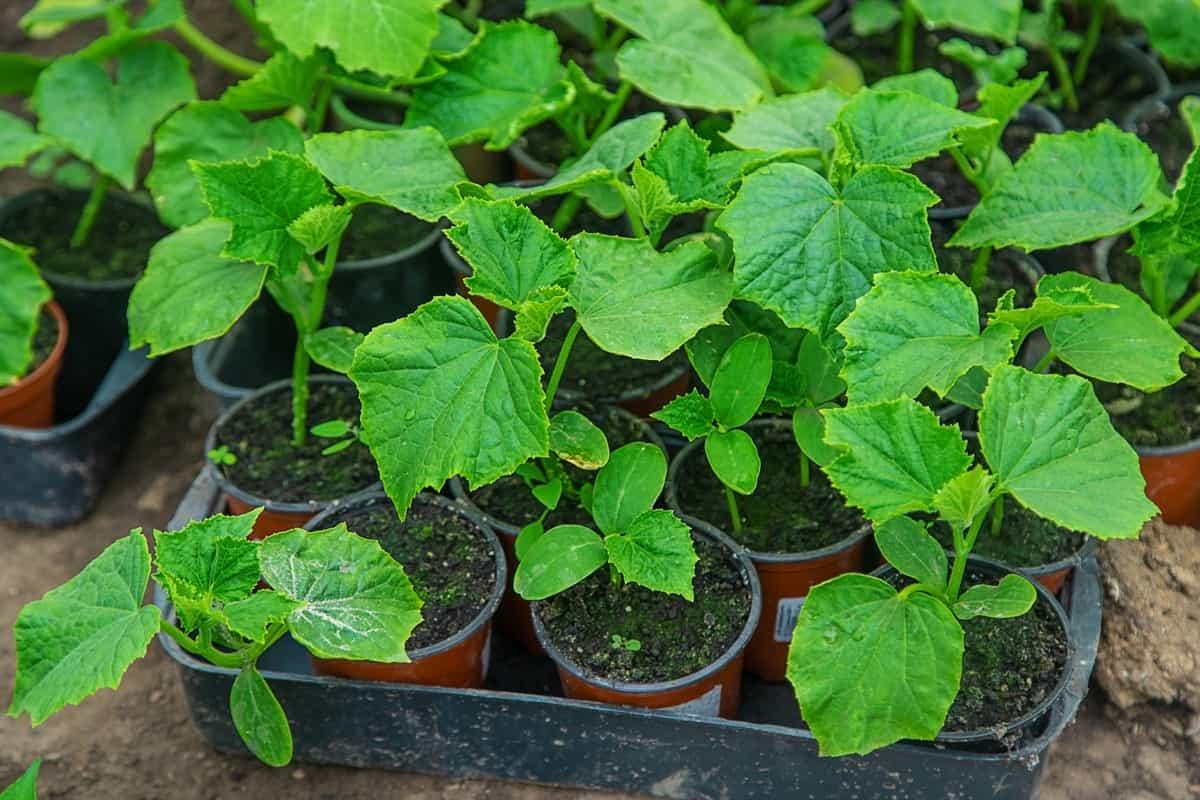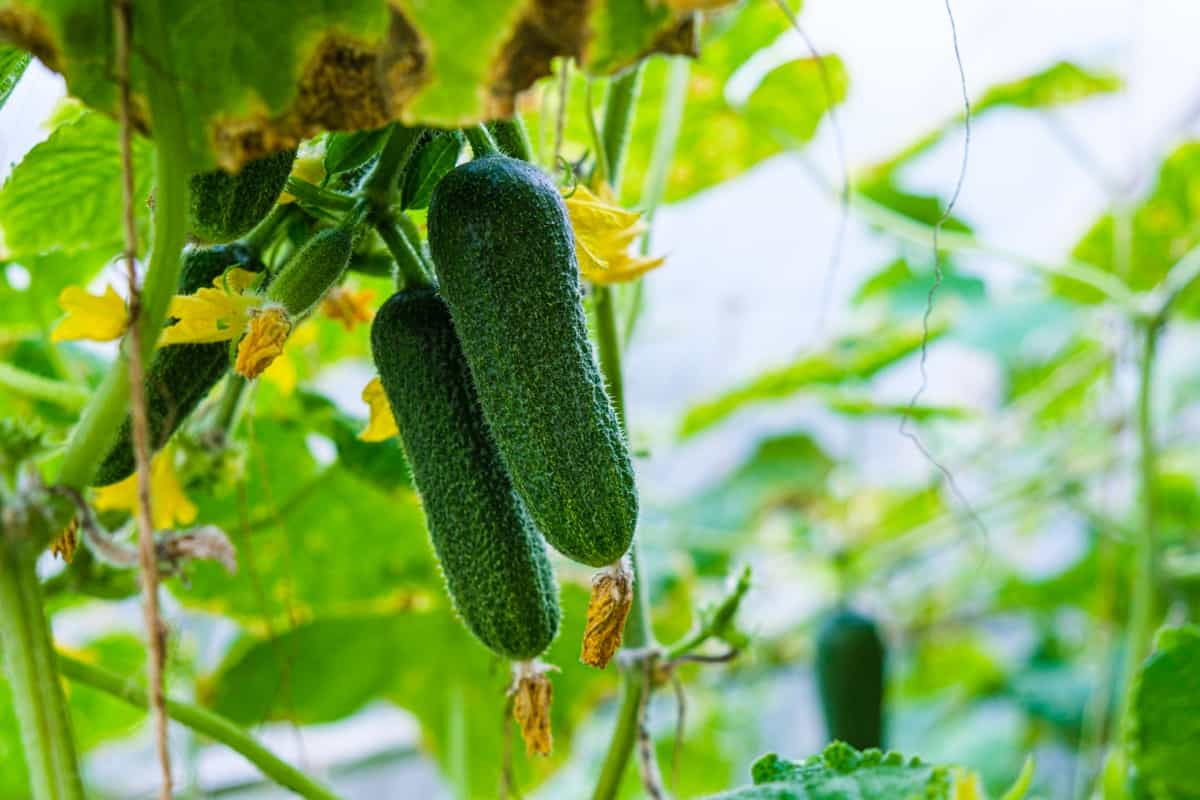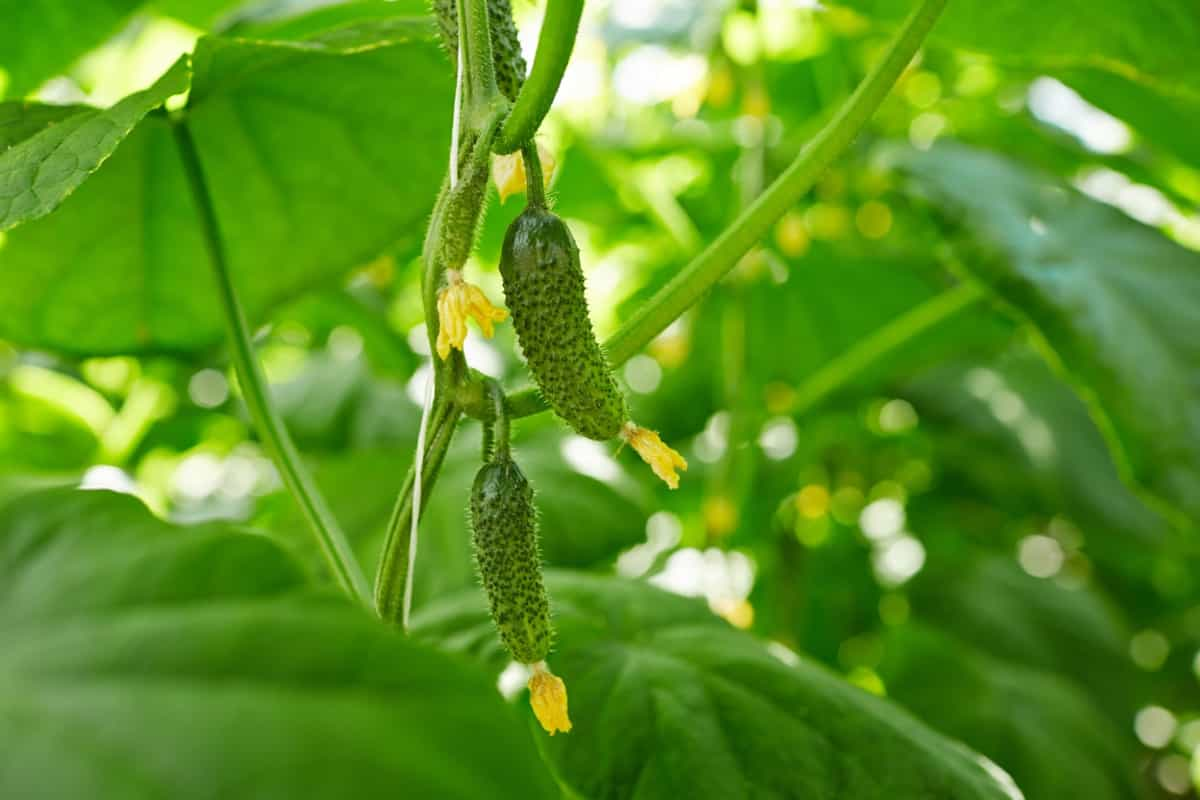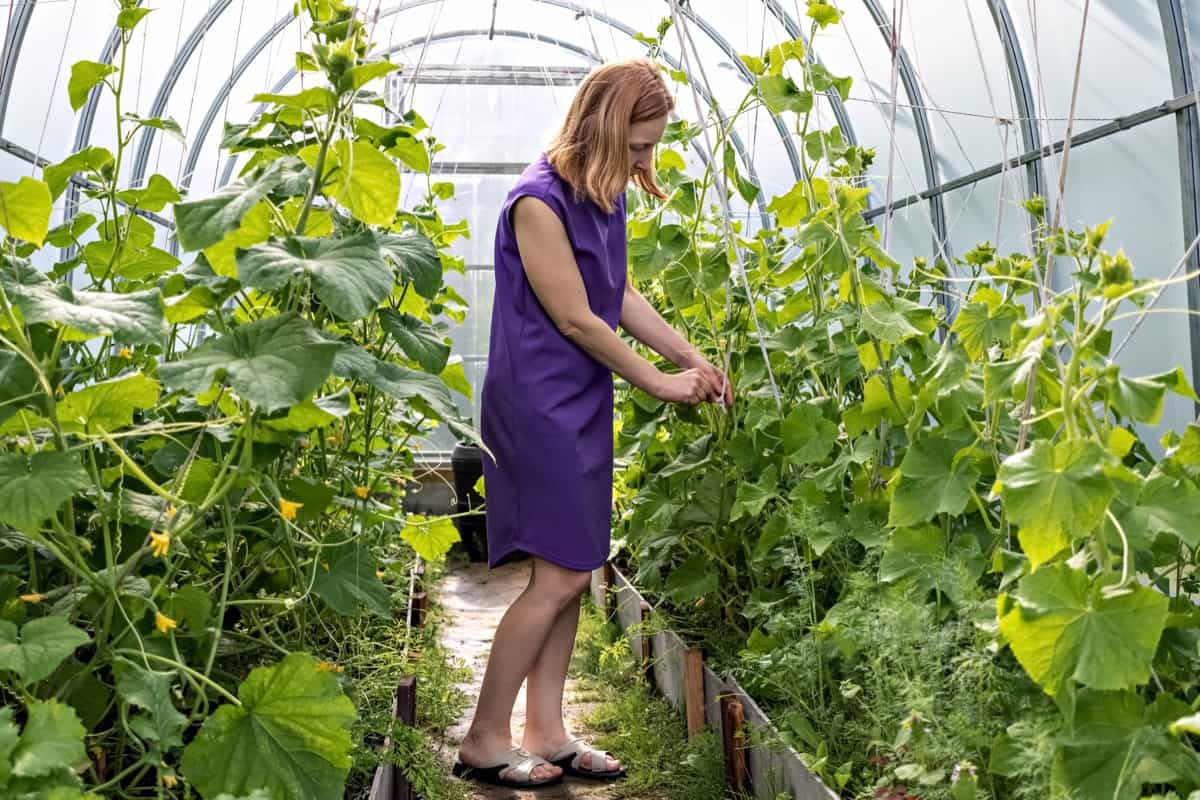The growth of a Cucumber plant is an interesting and rewarding process. Each stage requires different care and attention for optimal growth, from seed germination to fruit ripening. Understanding the various stages can help you identify potential problems early on and take corrective measures.

With patience and dedication, cultivating your homegrown Cucumbers can be a fulfilling experience that provides fresh produce for your family’s consumption. When it comes to pest management, avoid using harsh chemicals or pesticides that could harm beneficial insects like bees that help pollinate flowers. Instead, try organic methods such as companion planting or hand-picking pests. Let’s check out the stages of cucumber plant growth below.
Types of Cucumbers
Cucumbers come in various shapes, sizes, and colors. The most common types of Cucumbers are slicing Cucumbers, pickling Cucumbers, and seedless Cucumbers. Slicing Cucumbers are the most commonly grown type of Cucumber. They have dark green skin with white flesh inside and can grow up to 8 inches long. These Cucumbers are perfect for salads or eating fresh.
Pickling Cucumbers have bumpy skins, making them ideal for pickling. They also tend to be denser than slicing varieties. Seedless Cucumbers have thin skins that need not be peeled before consumption. They do not contain seeds, making it easier to eat raw. Knowing the different types of Cucumber available could help you choose the best one suited for your needs.
Stages of Cucumber Plant Growth
Sowing the Seeds
Sowing the seeds is the first stage of growing Cucumber plants. Before sowing, choosing a good location for planting Cucumbers is important. The ideal spot should be well-drained, receive plenty of sunlight, and have nutrient-rich soil. To sow the seeds, prepare the soil by removing any rocks or debris and loosening it with a garden fork. Place one or two Cucumber seeds in each hole and cover them with soil.
In case you missed it: How to Prevent Bitter Cucumbers and Grow Sweet and Juicy Fruits

Water gently but thoroughly to keep the soil moist until germination occurs. It’s important to note that temperature is essential in seed germination as Cucumbers require warm temperatures between 21-29°C. Therefore, planting them during late spring or early summer is better. Once planted, avoid overwatering, as this may cause fungal growth, harming your plants before they even start.
Germination
Germination is the second growth stage for Cucumber plants after sowing the seeds. It is an important process that marks the beginning of life for your Cucumbers. During germination, the seed absorbs water from the soil and breaks down its stored food to provide energy for growth. As soon as you sow your Cucumber seeds, they will absorb moisture from their surroundings.
The absorbed water softens the protective coat around each seed until it splits open, allowing a tiny sprout to emerge. Once these little shoots grow, they’ll reach their surrounding soil for nutrients and sunlight. From this point forward, proper care must be taken to ensure optimal plant growth.
Remember that Cucumber seeds are particularly sensitive to temperature fluctuations during germination, and excess watering can lead to rotting or damping-off disease. Therefore, it’s essential not to over-water at this stage since too much moisture could damage or even kill newly emerging shoots before they can fully develop. Germination is an exciting time for any gardener who has sown Cucumber seeds. Take care with watering and temperature fluctuations so your seedlings have all they need for healthy development.
Seedling
After the germination phase, the Cucumber seeds will grow into seedlings. During this stage, keeping them well-watered and in a warm environment with plenty of sunlight is important. You’ll notice their leaves become larger and more defined as they grow. During the seedling stage, one thing to watch out for is damping off disease, which can cause the plant stem to rot at the soil level. To prevent this, make sure not to overwater your plants and avoid overcrowding them.
In case you missed it: How to Build a Trellis for Cucumbers: A Step-by-Step Planting Guide for Beginners

You can also encourage healthy growth by fertilizing your plants once they’ve grown a few sets of true leaves. At this stage, it’s also a good idea to thin out your seedlings if you planted multiple seeds in each pot or cell pack. This will give enough space to grow without competing for resources with its neighbors. Taking care of your Cucumber seedlings ensures healthy plant growth later in the season.
More Plant Growth
After the seedling stage, Cucumber plants continue to grow and develop. By now, they should be a few inches tall with at least two or three leaves. As they mature, more leaves will sprout from the main stem. Cucumber plants are known for their vine-like growth habit. They tend to spread horizontally along the ground or climb trellises if properly supported. The stems can become quite lengthy, reaching several feet in length.
As the plant grows taller and wider, it’s important to have enough space to spread out and access sunlight. Crowded plants may start competing for resources like water and nutrients, which could hinder their growth. Proper pruning techniques can help control plant size and promote healthy fruit production. Removing old or diseased foliage can prevent pests and diseases from spreading throughout the plant. Proper care during this stage is crucial for optimal Cucumber growth and a bountiful harvest later on down the line.
Flowering
The male flowers have thin stems and do not produce fruit, while the female flowers are closer to the plant’s main stem and have a small swelling at their base, eventually developing into a Cucumber. It’s important to note that even though both types of flowers appear on the same vine, they don’t always bloom simultaneously. Female flowers typically appear after two weeks of male blooming. For pollination between these two flower types, insects like bees or butterflies must transfer pollen from one flower type to another.
It’s important not to use pesticides during this process as it could harm these beneficial insects. Once pollinated, the swollen base of female blooms begins developing into Cucumbers within 3-7 days, depending on variety and conditions such as temperature and water availability. Flowering is crucial in growing healthy Cucumbers with good yields; ensuring proper fertilization without impeding insect activity can improve overall health and ultimately enhance yields come harvest season.
Fruit Growth
One of the most exciting stages of Cucumber plant growth is when they start to produce fruit. This stage usually occurs around 40-50 days after germination, depending on the variety and growing conditions. As the plant matures, it will grow flowers that eventually become small Cucumbers. These tiny fruits will continue to grow until they reach their full size. During this period, it’s important to ensure the plants receive adequate water and nutrients to develop properly.
In case you missed it: Growing Cucumber from Seed to Harvest: A Detailed Guide for Beginners

Cucumbers are known for their rapid growth rate during fruiting. It’s essential to closely monitor your Cucumbers during this stage as they are prone to pests and diseases. Once your Cucumbers have reached their full size and have turned a dark shade of green (or yellow in some cases), it’s time for harvest.
Harvest
Harvest is the most important stage of Cucumber plant growth. It’s when all your hard work pays off, and you enjoy the delicious fruits of your labor. The timing of harvest is crucial, as Cucumbers can quickly become overripe. To determine if a Cucumber is ready for harvest, look at its size and color. Cucumbers should be firm and have a bright green color. If they are yellow or brown, it means that they are overripe.
When harvesting Cucumbers, use sharp scissors or pruning shears to cut them from the vine. Be careful not to damage the plant while doing so. Harvesting Cucumbers regularly is important, as this will encourage more fruit production. Leaving ripe Cucumbers on the vine too long can lead to bitter-tasting fruit.
Tips for Care of Your Cucumber Plant at Each Stage
Use a Soil Thermometer
A soil thermometer is essential for gardeners growing healthy and productive Cucumber plants. It allows you to accurately measure the temperature of your soil so that you can plant your seeds at the right time. When using a soil thermometer, it’s important to take readings at different depths in the soil because the temperature can vary depending on how deep you go.
In case you missed it: 16 Common Cucumber Plant Problems: How to Fix Them, Solutions, and Treatment

By knowing the exact temperature of your soil, you’ll also be able to determine if it’s too cold or too warm for Cucumbers. If it’s too cold, germination will be slow; seedlings could suffer from heat stress if it’s too hot. A soil thermometer can help ensure that your Cucumber seeds germinate quickly and evenly. Once they’ve sprouted, continue monitoring the temperature throughout their growth stages, as colder temperatures can stunt their growth while warmer temperatures can cause them to produce bitter fruit.
Consider Soaking Your Seeds
If you’re planning to grow Cucumbers, it’s important to know that starting with high-quality seeds is crucial. One way to ensure that your Cucumber plants have the best possible start is soaking the seeds before sowing them. Soaking Cucumber seeds can help speed up germination and give your plant a stronger start. Allowing water to penetrate the seed coat makes the embryo’s emergence easier. This process also helps soften any hard or tough outer layers around the seed, which may prevent proper moisture absorption.
To soak your Cucumber seeds, place them in a bowl or jar of warm water and let them sit for 12-24 hours. You’ll notice that they will swell up as they absorb water; this means they are ready to be planted. Taking care when planting your Cucumber seeds can make all the difference in how well they grow throughout each stage of their life cycle.
Give Plenty of Water
Cucumbers comprise about 95% water, so it shouldn’t be a surprise that they need plenty of moisture to grow and thrive. When it comes to watering your Cucumber plant, consistency is key. Make sure to give an inch of water each week. During hot summer, you may even want to increase the water you give them. It’s also important to note that Cucumbers need consistent moisture throughout their growing cycle.
Uneven watering can cause bitterness in the fruit or even stunted growth. In addition to regular watering, consider mulching around your Cucumber plants with organic materials like straw or leaves. This can help retain moisture and keep roots cool during hotter weather conditions. Providing ample consistent moisture is crucial for healthy Cucumber plants with high yields.
Use a Trellis
Cucumbers are known for their climbing abilities and can quickly become unruly without proper support. A trellis is a structure that allows your Cucumber plants to grow vertically instead of sprawling on the ground. This saves space in your garden and makes it easier to harvest your Cucumbers when they’re ripe.
When choosing a trellis, make sure it’s sturdy enough to support the weight of your growing plants. You can purchase pre-made trellises or construct one using bamboo or wire mesh materials. Using a trellis also has benefits besides saving space and making harvesting easier. It helps improve air circulation around the plants, which reduces the risk of fungal diseases and encourages better fruit production. A trellis is essential to caring for your Cucumber plant throughout its growth cycle.
Avoid Insecticides When You See Flowers
When your Cucumber plant starts to flower, it’s an exciting time. However, it’s important to remember not to use insecticides on your plants at this stage. Because these sprays can harm pollinators like bees and butterflies, which are essential for the fertilization process that produces fruit, without them, you might have fewer Cucumbers or none at all. One way of avoiding insecticides is by using natural methods like companion planting.
In case you missed it: Best Season to Grow Cucumber at Home in India: In Pots, Terraces, Apartment Balcony, and Backyards

For example, Marigolds have a scent that repels harmful insects, attracting beneficial ones like ladybugs and lacewings. Another method is handpicking pests off your plants or spraying them with a mix of water and dish soap instead of harsh chemicals. You can ensure a healthy harvest without harming the environment by being mindful of how you care for your Cucumber plant during each growth stage, including when flowers appear.
Conclusion
Growing Cucumbers is a rewarding experience that requires patience and care. Understanding the different stages of Cucumber plant growth is essential for ensuring a bountiful harvest. Each step is important in producing healthy plants, from sowing seeds to harvesting fruits. Remember to choose the right type of Cucumber for your needs, sow seeds appropriately, and provide adequate nutrition and water throughout the growth cycle. These tips allow you to enjoy fresh Cucumbers from your garden or balcony.
- How to Grow Tomatoes Organically at Home: A Comprehensive Guide
- Organic Gardening on a Budget: Low-Cost Methods and Materials
- Gongura Seed Germination and Planting Methods
- Cabbage Seed Germination and Selection
- Broccoli Seed Germination and Selection
- Asparagus Seed Germination and Variety Selection
- Seasonal Flower Gardening: Best Practices for Spring, Summer, Fall, and Winter
- How to Grow Hibiscus from Flower
- Plantation Ideas for Home Decoration: A Beginners Guide
- Flower Garden Designs and Layouts for Beginners
- Planting and Spacing Techniques in Papaya: A Beginner’s Guide
- Growing Gold: Essential Techniques for Planting Pineapples
- How to Make Kalanchoe Plant Bushy: Home Remedies and Solutions
- 11 Reasons Why Your Gardenia is Not Blooming: Home Remedies and Solutions
- Eco Elegance: The Guide to Designing a Drought-Tolerant Landscape
- Gardening on a Slope: Strategies for Hillside Landscaping
- Nourish and Flourish: Top Organic Mulches for Thriving House Plants
- Everything You Want to Know about Indian Mogra Flower: Discover Uses and Growing
- Green Thumb Success: Expert Tips for Cultivating Greenhouse Pumpkins All Year Round
- Maximize Growth & Flavor: The Ultimate Guide to Companion Planting in Herb Gardens
- How to Control Rhododendron Problems Naturally: Home Remedies and Organic Ways to Fix Them
- Natural Magic: The Remarkable Benefits of Cinnamon for Plants
- Best Steps to Revive Dying Tulip with Natural and Organic Treatment
- 10 Reasons Why Your Angel Trumpet is Not Blooming: Remedies and Treatment
- How to Fix Periwinkle Leaf and Flower-Related Problems: Natural Remedies and Solutions
- How to Fix Zinnias Leaf and Flower Problems: Discover Natural and Home Remedies
- Organic Steps to Induce Lemon Tree Flowers: A Comprehensive Guide
- Bloom Booster: Crafting the Perfect Homemade Bougainvillea Fertilizer
- Optimizing Growth: A Guide to Applying NPK Fertilizer for Potted Plants
- 10 Best Homemade Fertilizers for Rubber Plant: DIY Recipes and Application Method
- How to Boost Female Pumpkin Flowers: Effective Steps for More Flowers and High Yields
- Transform Your Indoor Garden: Top Benefits of Pink Salt for Houseplants
- 10 Best Homemade Fertilizers for Peacock Plants (Calathea): Easy DIY Guide
- Unlock Blooms: 9 Reasons Why Your Potted Chrysanthemum is Not Blooming
- 8 Reasons Why Your Potted Hibiscus is Not Blooming: Fix it with Simple Solutions
- Unlock Blooms: 9 Key Reasons Your Potted Frangipani Won’t Flower